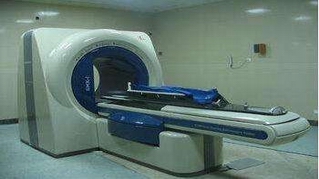目的
:先前的研究已經(jīng)證實(shí)抗RNA聚合酶III抗體(anti-RNAP III)陽性和抗著絲點(diǎn)抗體(anti-CENP),、抗拓?fù)洚悩?gòu)酶I抗體(anti-topo I)及anti-RNAP III均陰性的患者增加了發(fā)生腫瘤相關(guān)性硬皮病的風(fēng)險(xiǎn)。近期的一項(xiàng)研究報(bào)道的16例三種抗體全陰性的硬皮病同時(shí)合并腫瘤的患者中,,有1/4的患者體內(nèi)存在抗RNPC-3抗體,。本研究旨在評(píng)估抗RNPC-3抗體與腫瘤之間的關(guān)系,,同時(shí)在大樣本的硬皮病患者中觀察相關(guān)的臨床表型。
方法:
檢測合并腫瘤的硬皮病患者體內(nèi)anti-CENP, anti-topo I, anti-RNAP III, 和anti-RNPC-3抗體的水平,。比較不同自身抗體組間疾病的臨床特點(diǎn)和腫瘤與硬皮病發(fā)病之間的間隔,。通過邏輯回歸方法評(píng)估自身抗體狀態(tài)與腫瘤相關(guān)硬皮病之間的關(guān)系。
結(jié)果
:318例硬皮病合并腫瘤的患者中,,有70例anti-RNAP III抗體陽性,,有54例anti-topo I抗體陽性,有96例anti-CENP抗體陽性,。有12例患者存在anti-RNPC-3抗體陽性,。anti-RNPC-3抗體陽性的患者腫瘤發(fā)生與硬皮病發(fā)病間隔更短(平均0.9年)。與anti-CENP抗體陽性的患者相比,,anti-RNPC-3和anti-RNAP III抗體陽性的患者在硬皮病發(fā)病后的最初2年內(nèi)發(fā)展成腫瘤的風(fēng)險(xiǎn)增高大于4倍,。anti-RNPC-3抗體陽性的患者多具有嚴(yán)重的限制性肺疾病、胃腸受累,、雷諾現(xiàn)象和肌病,。
結(jié)論
:Anti-RNPC-3抗體與anti-RNAP III抗體類似,,與硬皮病發(fā)病后腫瘤發(fā)生風(fēng)險(xiǎn)增加相關(guān)。這些資料提示部分硬皮病患者存在腫瘤誘導(dǎo)的自身免疫性特點(diǎn),。
END
附原文:
OBJECTIVE
:Prior studies have demonstrated an increased risk of cancer-associated scleroderma in patients with anti-RNA polymerase III (anti-RNAP III) autoantibodies as well as in patients who are triple-negative for anticentromere (anti-CENP), anti-topoisomerase I (anti-topo I), and anti-RNAP III (also known as anti-POL) autoantibodies (referred to as CTP negative). In a recent study of 16 CTP-negative scleroderma patients with coincident cancer, 25% of the patients were found to have autoantibodies to RNPC-3, a member of the minor spliceosome complex. This investigation was undertaken to validate the relationship between anti-RNPC-3 antibodies and cancer and examine the associated clinical phenotype in a large sample of scleroderma patients.
METHODS
: Scleroderma patients with cancer were assayed for anti-CENP, anti-topo I, anti-RNAP III, and anti-RNPC-3 autoantibodies. Disease characteristics and the cancer-scleroderma interval were compared across autoantibody groups. The relationship between autoantibody status and cancer-associated scleroderma was assessed by logistic regression.
RESULTS
:Of 318 patients with scleroderma and cancer, 70 (22.0%) were positive for anti-RNAP III, 54 (17.0%) were positive for anti-topo I, and 96 (30.2%) were positive for anti-CENP. Twelve patients (3.8% of the overall group or 12.2% of CTP-negative patients) were positive for anti-RNPC-3. Patients with anti-RNPC-3 had a short cancer-scleroderma interval (median 0.9 years). Relative to patients with anti-CENP, patients with anti-RNPC-3 and those with anti-RNAP III had a >4-fold increased risk of cancer within 2 years of scleroderma onset (for anti-RNPC-3-positive patients, odds ratio [OR] 4.3, 95% confidence interval [95% CI] 1.10-16.9 [P = 0.037]; for anti-RNAP III-positive patients, OR 4.49, 95% CI 1.98-10.2 [P < 0.001]). Patients with anti-RNPC-3 had severe restrictive lung disease, gastrointestinal disease, Raynaud's phenomenon, and myopathy.
CONCLUSION
:Anti-RNPC-3 autoantibodies, similar to anti-RNAP III autoantibodies, are associated with an increased risk of cancer at the onset of scleroderma. These data suggest the possibility of cancer-induced autoimmunity in this subset of patients with scleroderma.
引自:Shah AA, Xu G, Rosen A, Hummers LK, Wigley FM, Elledge SJ, Casciola-Rosen L.Brief Report: Anti-RNPC-3 Antibodies As a Marker of Cancer-Associated Scleroderma. Arthritis Rheumatol. 2017 Jun;69(6):1306-1312. doi: 10.1002/art.40065.







